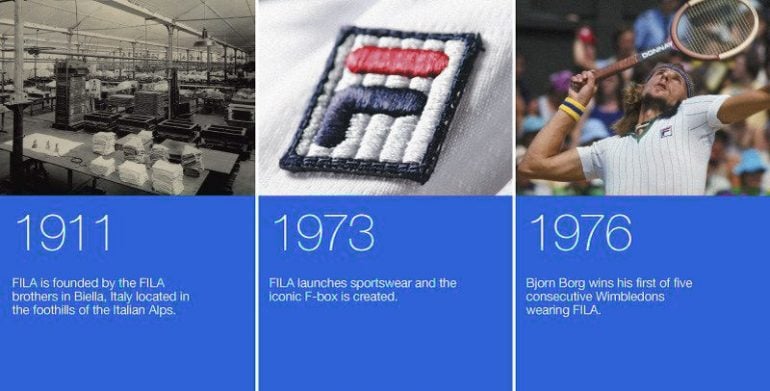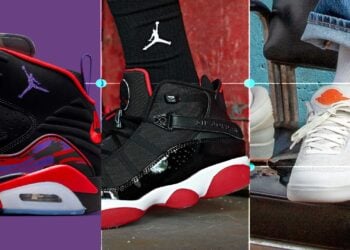As with many global sneaker brands, Fila, too, has a long and rich history dating back more than a hundred years. While it may have established its roots in Italy, the company has achieved global recognition and expansion and is now headquartered in South Korea. With such an extensive history, it’s definitely worth taking some time to explore and unpack – and that’s exactly what we did.
The Early Years of Fila

It all started in 1911, when the two Fila brothers from Biella, a small town in the foothills of northern Italy, started the company as a textile manufacturer for the local townspeople. In a search to produce more luxury fabrics, they started incorporating elements of art and utility, drawing inspiration from their homeland, the Italian landscape – from the simplicity and beauty of the Alps to the fluidity of the hills along the Mediterranean coast.

The company’s growth and expansion of the Fila brand has, over the years, continually transformed, driven by an evolution of its philosophy, allowing it to grow to the leading global designer of high-end sportswear it is today. One of the biggest changes for the company occurred in 1923 when the brothers officially established themselves as a knitwear manufacturing company while also entering into a partnership with Maglficio Biellese. This allowed the business to grow beyond the town it was established in and eventually expand beyond even the borders of Italy.
A few years later, it expanded once again, merging with the Fratelli Fila company in 1942. In 1968, Giansevero Fila hired Enrico Frachey as the company’s Managing Director. Frachey shared Fila’s vision, and the duo began work on transforming the company into a global sportswear brand, moving away from the textile and underwear manufacturer it started off as a few decades earlier.
By 1972, the company had reached sales of over one billion Lire and a workforce of more than 250 people under the creative and managerial guidance of Frachey, who had also enlisted the help of innovative artist and designer Pier Luigi Rolando, and an engineer, Alessandro Galliano, to help the company’s new vision. RELATED: The 7 Sneakers That Echo Tupac “2Pac” Shakur’s Legacy
Becoming a Sportswear Brand

Now operating as a sportswear brand, one of the first sports Fila aimed to conquer was tennis, endorsing numerous leading players from the time, including Bjorn Borg and, in later years, Boris Becker, Jennifer Capriati, and Monica Seles and Kim Clijsters. While the company was able to carve out a reputation in the world of tennis, the brand still continued to lack sales in the United States, behind Nike and Reebok.
In 1994, Fila aimed to change this by signing an endorsement deal with NBA star Grant Hill, along with World Cup 94-winning skier Alberto Tomba. This marked a change in fortunes for the brand as it continued its tug-of-war with Nike and Reebok. The ’90s also saw a huge increase in sales within the South African market, with most kids growing up during that era owning a pair of Fila sneakers – myself included.
By the end of the decade, after having dominated the tennis scene, breaking trends such as the all-white silhouette, the brand finally established itself across various other sporting codes, including baseball, basketball, football and motorsport.
The Fila Logo History

During their rise in the sporting world, Fila adopted a new logo in the 1980s. The Fila logo received artistic treatment of the letter F, comprising snakelike letters, which gave it a highly futuristic and elegant look. The red bar in the F represents vitality, vigour and passion. The blue colour, on the other hand, represents the trustworthiness and reliability of the brand. The Fila logo remains strikingly memorable today, as it once again aims to dominate the world.

The Shake-Up
The 2000s was a tricky period for the company in terms of sales and brand awareness across the globe. This led to numerous acquisitions, mergers, and the like during this time. The original Italian ownership shop, Holding di Partecipazioni, sold the company to US hedge fund Cerberus Capital Management in 2003 due to a number of failed endorsements and over-commitment.
Cerberus owned Fila through a holding company, Sports Brands International, owning and operating Fila around the world, except for South Korea, where Fila Korea operates as a separate company under licence. This would prove to be pivotal to its survival, as in 2007, the global Fila brand and all its subsidiaries were acquired by Fila Korea from SBI, making it the largest South Korean sportswear company. It currently holds all the rights to the worldwide use of footwear and clothing brands. That same year, Fila partnered with GLBH – Global Leading Brands House – a fashion organization aimed at helping companies in developing high-end fashion products. With this new partnership in place, Fila established one of its headquarters in Milan, the fashion capital of the world.
Fila Reborn

During the next few years, the brand worked its way back up to earn its place amongst the top tier in designer sneakers and apparel. In 2017, Fila’s collaboration with fashion brand Pink Dolphin Clothing produced the cage silhouette, which was released in white and black colourways and almost immediately sold out in stores. This emphatically marked the return of the Fila brand on a global scale, having seen a growing in its presence in the market as well over the last year, tapping into its rich history and nostalgia it has in the country.
It looks like Fila’s history continues well into 2024, with new sneaker drops released monthly. RELATED: Fila x Safa Sahin SAWW Sneaker: Redefining Bold Streetwear Style











